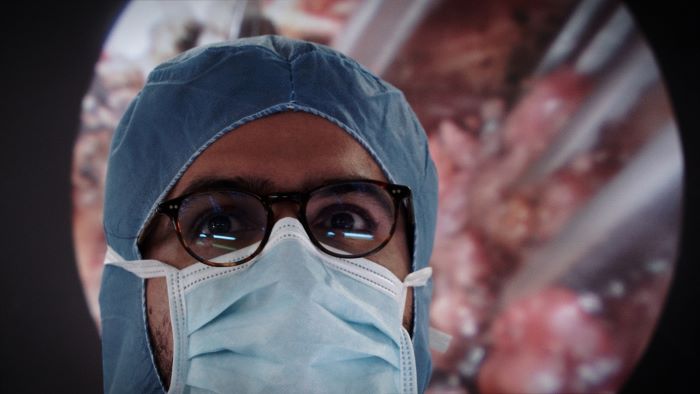![]() Bodies, are you ready for a close-up? We can easily assume that progressive technological advancements have impacted the field of medicine in such a manner that the inside of our bodies have long ceased to be uncharted domain. However, there is a great difference between what we believe we know (unless trained in the medical field) and the exact evidence of what a journey inside the body would look like. That is precisely what the immersive documentary De Humani Corporis Fabrica, directed by the filmmaking team of Lucien Castaing-Taylor and Véréna Paravel, offers. It provides a detailed perspective of what many surgical procedures look like from the inside, as you have probably never seen before. Theoretically, this does not sound pleasant to watch and may require an empty stomach, but ultimately it provides the satisfaction of having dared to experience something unique.
Bodies, are you ready for a close-up? We can easily assume that progressive technological advancements have impacted the field of medicine in such a manner that the inside of our bodies have long ceased to be uncharted domain. However, there is a great difference between what we believe we know (unless trained in the medical field) and the exact evidence of what a journey inside the body would look like. That is precisely what the immersive documentary De Humani Corporis Fabrica, directed by the filmmaking team of Lucien Castaing-Taylor and Véréna Paravel, offers. It provides a detailed perspective of what many surgical procedures look like from the inside, as you have probably never seen before. Theoretically, this does not sound pleasant to watch and may require an empty stomach, but ultimately it provides the satisfaction of having dared to experience something unique.
The title refers to the idea of the human body as a machine, but it is the invasive images, achieved through microscopic cameras, that reveal the nature of those “gears” that allow its functioning, as well the required “repairs” when something has “broken down.” The visuals go beyond what you may have seen in a traditional colonoscopy or ultrasound, filmed from the point of view of the doctors’ operating tools—an intestinal exploration and a cesarean birth are some of the procedures shown.
The surgeries are both grotesque and fascinating, even without viewers knowing what type of procedure is happening on-screen. A cornea replacement confronts us with a gripped eye in constant tension due to its reflexes, but the most terrifying part to witness is when a lens is methodically inserted as a tiny object that then expands and requires proper adjustment. In another sequence, a tube inside the urethra exposes a penis being drilled, a terrifying image that will make men tremble with the fear of castration. Other explorations happen so deep internally that it’s hard to pinpoint what we’re seeing, but there’s never a lack of blood or fluids to remind you that it’s a human body and not an unknown planet. The film takes advantage of our hypothetical medical ignorance to make us witnesses of images that conjure wonder and horror as we get used to what we look like underneath our skin. When a doctor expresses confusion and alarm performing a surgery, the suspense is palpable, especially during a crucial suture amid a progressive internal bleed.
Occasionally, we hear doctors and nurses speaking in the middle of these processes or afterward, though not as guides or narrators. Instead, these conversations range from the personal to routine, with laments about stress, jokes that surely alleviate fears or tensions, and direct complaints about budget cuts, work overload, and reduced staff that offer a wider view of the public health services in France. Nurses from an ICU discuss patient flow and the convenience of not becoming sentimentally attached to patients while revealing curious superstitions—there is no room number 13. Elderly mental patients wander around one of the hospital wards, and there are no further details about who they are or why they are there. As a result, the film not only concerns itself with journeys to the unknown dimension of the human body but also with the political and social aspects of the health care system. However, these reflections are too casual compared to what distinguishes the rest of the documentary.
Castaing-Taylor and Paravel have created the kind of film where the conception is as decisive as the content represented, similar in nature to conceptual and experimental art. Considering that part of the filmed material uses doctors as the authors behind the footage, the film inspires the question of what we consider art, to ponder what makes the difference between material presented at a medical conference versus images assembled for cinema. At some point, one doctor asserts that what is captured by the camera is beginning to become abstract, and it is inevitable not to think that the statement defines the experience of watching this movie. What initially seems destined to churn our stomachs and create a shock effect is subsequently naturalized with clinical detachment until we end up lost in contemplation.
De Humani Corporis Fabrica resists becoming pedagogical and informative to its advantage. Instead, it provides tangible evidence: There is art to be found inside of us.







Leave A Comment